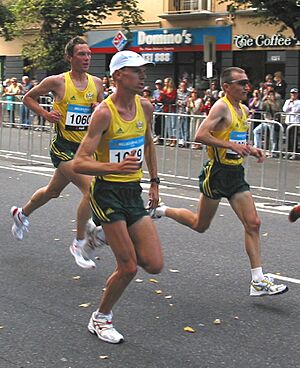National colours of Australia facts for kids
The national colours of Australia are green and gold. These colours were officially chosen on April 19, 1984. This decision was made by the Governor-General of Australia, Sir Ninian Stephen, following advice from Prime Minister Bob Hawke. The Governor-General is the King's representative in Australia, and the Prime Minister is the head of the Australian government.
The gold colour reminds us of the golden wattle, which is Australia's national flower. You'll often see these colours on the uniforms of Australia's national sports teams. The golden wattle flower and the green and gold colours are also proudly shown on the Coat of arms of Australia.
The Australian government says that for the colours to be used correctly, they should be placed right next to each other, with no other colour in between. The exact shades of green and gold are specific. They are called Pantone 348C for green and Pantone 116C for gold. The colours are always known as 'green and gold'.
| Green | Gold | Sources | |
|---|---|---|---|
| Pantone | 348 C | 116 C | |
| RGB (Hex) |
0–132–61 (#00843D) |
255–205–0 (#FFCD00) |
|
| CMYK | 100%–0%–54%–48% | 0%–20%–100%–0% |
Contents
Other Colours Used in the Past
Before green and gold became official, other colour combinations were sometimes used to represent Australia:
- Blue (from New South Wales) and maroon (from Queensland) were used together by the Australia National Rugby League Team from 1908 to 1928. They have also appeared on special jerseys since then. The Australia National Rugby Union Team also used these colours from 1899 to 1929.
- Red, white, and blue.
- Blue and gold.
|
|
| 1908–1928, 1963, 2008, 2014 |
According to the Australian government, green and gold have been popular as Australia’s national sporting colours since the late 1800s. Almost every Australian national sports team wears them today. The exact shades and how much of each colour is used might change between teams and over time. Australia's cricket team first wore these colours in 1899. This was seen in the baggy green, a special cap given to Australian cricket players.
The History of Green and Gold
The first Australian national sports team to wear green and gold was the Australian cricket team. This happened when they toured England in 1899. Their playing clothes were still white, but the team captain, Joe Darling, made sure they wore green and gold caps and blazers. This was for the first match of the Ashes series.
Before this, the cricket team didn't have a set uniform. Players would wear caps or blazers from their own clubs or states. After 1899, the Australian cricket team kept using green and gold. In 1908, these colours were officially chosen as the team colours for all future Australian cricket teams. During discussions, people reportedly called the colours "gum-tree green" and "wattle-gold".
The Australasian Olympic team also started using "green and wattle" in 1908. However, not every team wore these colours at first. In the 1912 Olympics, an official Australian uniform was used for the first time. It included green vests with gold trim, and white shorts with green and gold trim.
For football sports, the Australian national soccer team first wore green and gold in 1924. The Australian national rugby league team followed in 1928, and the Australia national rugby union team in 1929.
Where You See Green and Gold Today

Australian Sports Teams
Many Australian sports teams proudly wear green and gold. Some of these teams include:
- The Australia cricket team (for one day cricket and Twenty20 cricket).
- The Australian Summer Olympics team.
- The Wallabies (rugby union).
- The Kangaroos (rugby league).
- The Jillaroos (rugby league).
- The Wallaroos (rugby union).
- The Diamonds (netball).
- The Socceroos (men's association football, also known as soccer).
- The Matildas (women's association football, or soccer).
- The Boomers (men's basketball).
- The Opals (women's basketball).
- The Kookaburras (men's field hockey).
- The Hockeyroos (women's field hockey).
- The Mighty Roos (ice hockey).
- The Australia national baseball team in the World Baseball Classic.
- The Australia national lacrosse team, known as the Sharks.
- Team Australia on UFC The Smashes The Ultimate Fighter: The Smashes.
- The Wizards of Aus, Australia's men's roller derby team.
- The Australian Outback Gridiron Team.
Since 1961, the Wallabies rugby union team has worn a gold jersey with green writing and trim. They changed from a mostly green jersey to avoid clashing colours with the Springboks team from South Africa.
Other Places You See the Colours
The green and gold colours have also been used by some companies and organisations. For example, around 1981, the government railway company Australian National used these colours on their trains. This company was formed by joining several railway groups.
- Australian Made logo (a logo for products made in Australia).
- Australian National Line (a shipping company).
- Medicare Australia (Australia's public health insurance system).
- National Party of Australia (a political party).

